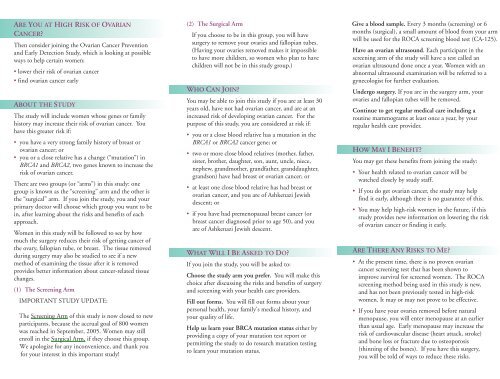Brochure - Ovarian Cancer Prevention and Early Detection Study
Brochure - Ovarian Cancer Prevention and Early Detection Study
Brochure - Ovarian Cancer Prevention and Early Detection Study
Create successful ePaper yourself
Turn your PDF publications into a flip-book with our unique Google optimized e-Paper software.
ARE YOU AT HIGH RISK OF OVARIANCANCER?Then consider joining the <strong>Ovarian</strong> <strong>Cancer</strong> <strong>Prevention</strong><strong>and</strong> <strong>Early</strong> <strong>Detection</strong> <strong>Study</strong>, which is looking at possibleways to help certain women:• lower their risk of ovarian cancer• find ovarian cancer earlyABOUT THE STUDYThe study will include women whose genes or familyhistory may increase their risk of ovarian cancer. Youhave this greater risk if:• you have a very strong family history of breast orovarian cancer; or• you or a close relative has a change (“mutation”) inBRCA1 <strong>and</strong> BRCA2, two genes known to increase therisk of ovarian cancer.There are two groups (or “arms”) in this study: onegroup is known as the “screening” arm <strong>and</strong> the other isthe “surgical” arm. If you join the study, you <strong>and</strong> yourprimary doctor will choose which group you want to bein, after learning about the risks <strong>and</strong> benefits of eachapproach.Women in this study will be followed to see by howmuch the surgery reduces their risk of getting cancer ofthe ovary, fallopian tube, or breast. The tissue removedduring surgery may also be studied to see if a newmethod of examining the tissue after it is removedprovides better information about cancer-related tissuechanges.(1) The Screening ArmIMPORTANT STUDY UPDATE:The Screening Arm of this study is now closed to newparticipants, because the accrual goal of 800 womenwas reached in September, 2005. Women may stillenroll in the Surgical Arm, if they choose this group.We apologize for any inconvenience, <strong>and</strong> thank youfor your interest in this important study!(2) The Surgical ArmIf you choose to be in this group, you will havesurgery to remove your ovaries <strong>and</strong> fallopian tubes.(Having your ovaries removed makes it impossibleto have more children, so women who plan to havechildren will not be in this study group.)WHO CAN JOIN?You may be able to join this study if you are at least 30years old, have not had ovarian cancer, <strong>and</strong> are at anincreased risk of developing ovarian cancer. For thepurpose of this study, you are considered at risk if:• you or a close blood relative has a mutation in theBRCA1 or BRCA2 cancer gene; or• two or more close blood relatives (mother, father,sister, brother, daughter, son, aunt, uncle, niece,nephew, gr<strong>and</strong>mother, gr<strong>and</strong>father, gr<strong>and</strong>daughter,gr<strong>and</strong>son) have had breast or ovarian cancer; or• at least one close blood relative has had breast orovarian cancer, <strong>and</strong> you are of Ashkenazi Jewishdescent; or• if you have had premenopausal breast cancer (orbreast cancer diagnosed prior to age 50), <strong>and</strong> youare of Ashkenazi Jewish descent.WHAT WILL I BE ASKED TO DO?If you join the study, you will be asked to:Choose the study arm you prefer. You will make thischoice after discussing the risks <strong>and</strong> benefits of surgery<strong>and</strong> screening with your health care providers.Fill out forms. You will fill out forms about yourpersonal health, your family's medical history, <strong>and</strong>your quality of life.Help us learn your BRCA mutation status either byproviding a copy of your mutation test report orpermitting the study to do research mutation testingto learn your mutation status.Give a blood sample. Every 3 months (screening) or 6months (surgical), a small amount of blood from your armwill be used for the ROCA screening blood test (CA-125).Have an ovarian ultrasound. Each participant in thescreening arm of the study will have a test called anovarian ultrasound done once a year. Women with anabnormal ultrasound examination will be referred to agynecologist for further evaluation.Undergo surgery. If you are in the surgery arm, yourovaries <strong>and</strong> fallopian tubes will be removed.Continue to get regular medical care including aroutine mammograms at least once a year, by yourregular health care provider.HOW MAY I BENEFIT?You may get these benefits from joining the study:• Your health related to ovarian cancer will bewatched closely by study staff.• If you do get ovarian cancer, the study may helpfind it early, although there is no guarantee of this.• You may help high-risk women in the future, if thisstudy provides new information on lowering the riskof ovarian cancer or finding it early.ARE THERE ANY RISKS TO ME?• At the present time, there is no proven ovariancancer screening test that has been shown toimprove survival for screened women. The ROCAscreening method being used in this study is new,<strong>and</strong> has not been previously tested in high-riskwomen. It may or may not prove to be effective.• If you have your ovaries removed before naturalmenopause, you will enter menopause at an earlierthan usual age. <strong>Early</strong> menopause may increase therisk of cardiovascular disease (heart attack, stroke)<strong>and</strong> bone loss or fracture due to osteoporosis(thinning of the bones). If you have this surgery,you will be told of ways to reduce these risks.


